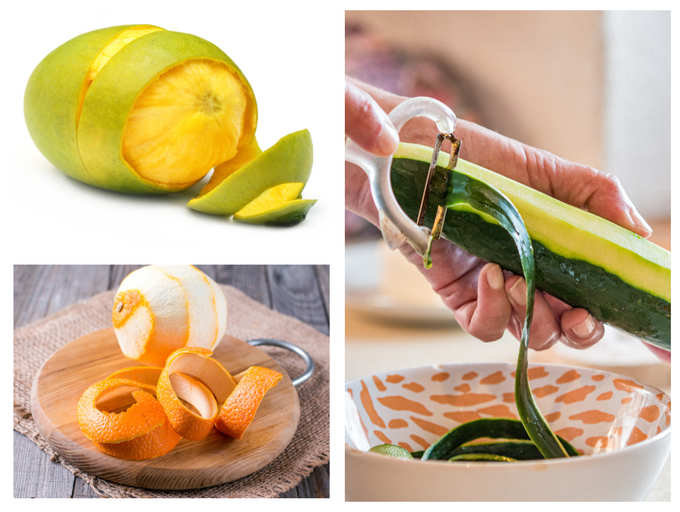3 Myths About Eating Fruit and Veggie Peels – As the saying goes, an apple a day keeps the doctor away—but will that carry even greater truth if you choose to peel said apple?
How about if you keep the skin on with your other go-to fruits and veggies? Also, is it *always* better to buy organic produce to reduce the potential risks of pesticide exposure?
In order to separate fact from fiction when it comes to eating peels of fruits and vegetables, we reached out to Tamika Sims, PhD, Senior Director of Food Technology Communications at the International Food Information Council (IFIC). Keep reading for some much-needed mythbusting.
3 Myths About Eating Fruit and Veggie Peels
Myth #1: It’s dangerous to eat fruit and veggie peels due to pesticide exposure
There’s a lot of talk purporting that eating the peels of fruits and vegetables is risky, namely due to the potential of pesticide ingestion. For that reason, some sources claim that it’s safer to peel your produce before eating it to reduce your intake of these chemicals… but how valid are these claims, and how concerned should you really be?
Simply put, if you’re losing sleep over this matter—or at the very least making your peeler work overtime out of concern—Dr. Sims wants to put this myth to rest. “Potential residues on produce are in minute amounts that are not linked to any adverse health effects,” she says. “The U.S. Department of Agriculture’s Agricultural Marketing Service has issued reports confirming that overall pesticide chemical residues found on foods are at levels below the tolerances established by the U.S. Environmental Protection Agency and do not pose a safety concern.”
The USDA releases the Pesticide Data Program (PDP) Annual Summary, which tests over 100 commodities—including fruits and veggies, but also dairy, meat, poultry, grains, fish, rice, and water—to gauge food safety specific to pesticide levels. The 2019 PDP Annual Summary found that almost 99 percent of nearly 10,000 samples of fresh, frozen, and processed foods contained pesticide residue below the EPA’s threshold for concern. Meanwhile, the 2020 PDP Annual Summary showed that over 99 percent of the samples tested had pesticide residue below this same benchmark.
In other words, if you enjoy eating the peels of fruit and veggies, rest assured that it’s safe to do so.
Myth #2: It’s much safer to eat the peels of organic produce
Another myth that Dr. Sims wants to clear up is the idea that organic produce is fully free from pesticides, and thus their peels are inherently safer to eat. “This isn’t quite the case. Both conventional and organic produce are grown with the use of pesticides,” Dr. Sims says. (For reference, studies show that the latter may contain lower amounts of pesticides and other chemicals.) Yet this fact shouldn’t discourage you from eating either variety on a consistent basis to promote good health and well-being.
“Conventional and organic produce both present a healthy and safe way to obtain daily nutrients; neither is safer or healthier than the other,” adds Dr. Sims. She says this goes for any type of produce, whether they have edible peels/skin (think apples, carrots, and cucumbers) to those that have peels you’ll typically discard (such as pineapples, avocados, and onions).
Again, Dr. Sims reiterates that the rewards of eating a produce-rich diet—with peels on or off—highly outweigh potential risks. “Whether you choose organic or traditionally produced fruits and vegetables, the important thing is to get plenty of servings of fruits and vegetables each day,” she says. Moreover, she emphasizes the importance of safe food handling in order to prevent foodborne illness, which includes thoroughly washing, storing, and preparing produce.
Myth #3: Peels are trash and should get tossed out
Of course, some people simply prefer the taste and texture of peeled produce. All good! Plus, some recipes call for fruits and veggies with the skin off. But in most cases, as we’ve clarified, there’s no need to throw these scraps out over safety concerns. As Dr. Sims explains, there are many ways to repurpose them—including those you typically wouldn’t enjoy on their own, such as the peels of lemons, limes, and oranges.
“Citrus peels are often discarded, but they can be candied, used as a drink garnish, or added to infused water,” Dr. Sims says—but the creativity doesn’t stop there. “Alternatively, we can also zest peels before using the citrus fruit and place the zest in air-tight bags or containers in the freezer to be used later in baked goods or sprinkled on yogurt or oatmeal.”
Citrus aside, other peels—including but not limited to those of carrots, cucumbers, potatoes—are also worth keeping on hand for a variety of additional uses. “Vegetable peels can also be saved and frozen to later be used as base for soup broths or cooking sauces,” Dr. Sims adds.
Finally, if you still have leftover fruits and veggie peels, she notes that composting is a great option to repurpose them and minimize food waste. “When these scraps can’t be further utilized, composting is the next best thing,” Dr. Sims says. If you’re new to composting, she recommends heeding advice from the EPA.
Final Note…
All things considered, to peel or not to peel is a question that you’ll have your own answer to based on your personal preferences, given recipes, and the produce item at hand. Whichever route you choose, rest assured the concentration of pesticides (and thus their potential health risks) are minimal, and that fruits and veggies are always part and parcel of a well-rounded diet.








